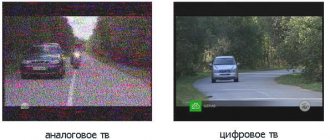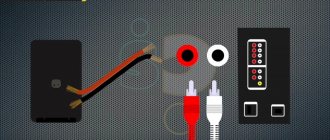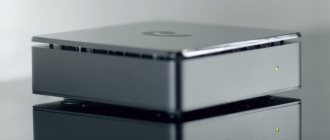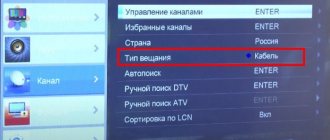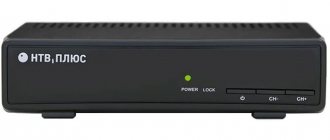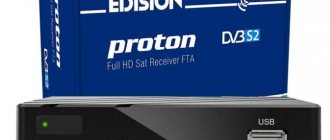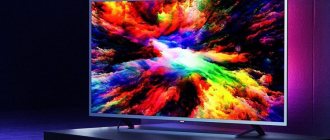Currently, all Russian digital television uses the DVB-T2 format, but many still have receivers that use the DVB-T broadcast standard.
To understand what the difference in markings means, you need to understand the very principles of digital broadcasting. This will be discussed in the article.
What is DVB-T
DVB-T and DVB-T2 what is it - means Digital Video Broadcasting or digital video broadcasting, while the marking - T (Terrestrial) characterizes the broadcast as terrestrial.
Important! In the Russian Federation, the format of such broadcasting began to be used in the early 2000s, and was adopted as a unified European standard.
For television broadcasting in this format, the standard used is COFDM, that is, split signal encoding. Data is transmitted at speeds of up to 30 Mbit/s and is encoded in Mpeg-2 format with appropriate audio.
TV broadcasting has been improved by improving the quality of the following features:
- The magnitude of the input signal was significantly reduced, due to this it was possible to reduce both the power of the receiver and the source.
- The balance of noise and signal was equalized, which improved the picture quality.
- Confident reception increased the range.
- Even if the signal source moved, reception remained stable.
- An indoor antenna can pick up the signal.
Multicast ABR
The second technology included in DVB-I is Multicast ABR. It was adopted in March of this year. Common streaming formats are based on unicast (point-to-point). This scheme is tailored for the delivery of on-demand services and scales well through the use of caching servers installed at the edge of content delivery networks (CDNs). However, for the delivery of linear services it is completely unjustified. Therefore, the DVB Project considered it necessary to supplement DVB-DASH LLC with multicast functionality (point-to-multipoint).
The essence of the technology is to add a multicast server and a multicast gateway to the delivery chain. The server is installed at the edge of the CDN and receives content from this network using the same protocols as the playback device (player). The multicast gateway is installed on the subscriber side and can be external or built-in, for example, into a home media gateway. It distributes the received signal to home devices in a unicast format they understand and in CMAF media containers. The multicast network between the server and the gateway can operate using any technology that allows UDP/Multicast. This could be an Ethernet, HFC/DOCSIS, XDSL, PON or even satellite network. The technology is not yet applicable to the open Internet, because there is no guarantee that all routers along the signal path will support multicast and understand IGMP requests. To solve this problem, Cisco has developed a mechanism for tunneling multicast traffic. In addition, there are tools that increase the reliability of multicast traffic transmission over the open Internet, but they are not yet included in the standard. In its current form, the technology is applicable only to operator networks.
To implement Multicast ABR, two main options are considered. The first is with an HTTP channel, through which the multicast gateway can communicate with the CDN and receive from there segments lost in the multicast network, just as the player does. The second option is a unidirectional network without an HTTP channel. This option can most likely be deployed on the basis of a satellite network that does not provide a terrestrial channel.
Thus, MPEG CMAF LLC in combination with Multicast ABR makes it possible to create a transport system comparable to broadcast systems in terms of signal delay and efficiency of using the transport network.
What is the difference between DVB-T2 and DVB-T
The two formats are incompatible, despite the fact that almost the same principle is used. The differences lie in the qualitative increase in characteristics:
- Audio and video are encoded in Mpeg-4, as opposed to the legacy mpeg-2.
- One stream of encoded signal fits into two more channels, while the degree of compression of the encoded signal allows for fast decoding.
- Data of different structure is transmitted in one channel stream. For this, Physical Layer Pipe or PLP technology is used, that is, several backbone layers are created. This frees up broadcast time.
Thus, the new broadcasting standard made it possible to:
- Increased channel data transmission speed by 1.7 times.
- Increasing the volume of content (teletext).
- Improved frame resolution by increasing it to 16:9.
- Increased reception of a coded signal at a great distance from the television center and relay towers.
- Freeing up radio frequencies due to signal compression. Frequencies can be used to improve sound quality.
- Provides a reliable level of protection against interference.
TVs or DVB-T set-top boxes to receive a digital signal
Tuners and televisions have a label indicating that if the DVB-T broadcast standard is specified, then the device can be used to receive an encoded digital signal. A digital signal can work together with an analog signal when switching.
Initially, all television receivers were equipped with a decoder for digital broadcasting, since after the 2000s a global transition to digital broadcasting was planned. Devices based on semiconductors and liquid crystals, as well as third-generation TVs without the SmartTV function, do not have this capability.
History of the development of digital technologies
The development of digital television is directly related to the evolution of information technology. Initially, compression of information into binary digital code was introduced in computer technology. Thanks to this approach, it became possible to place more voluminous information on a compact disc (DVD/CD). Consequently, video material of longer duration or higher resolution could be placed on the media.
With the advent of high-definition televisions, digital technologies were applied to television. Different standards for digital television broadcasting are being introduced around the world. In Russia, the European digital TV standard DVB is used. Each standard differs only in regional affiliation and has the same characteristics.
Connection of DVB-T and DVB-T2 standard
In order to determine whether the television receiver has the ability to connect to the digital broadcasting standard, you need to examine the markings on the product packaging. If there is an appropriate abbreviation, the device can be used to decode digital channel broadcasts.
If there is no corresponding marking on the package, this does not mean that this option is not available.
You need to inspect the back of the TV.
Usually the following devices are structurally made on it:
- Plug and adapter for connecting analogue television.
- Plug and adapter for connecting a fiber optic network.
- Special plug for digital channel reception.
The special plug is made in the form of an oblong connector, which in TV jargon is called a “tulip”.
The oblong, rectangular connector has 4 pall/secam connectors inside the groove. Through them, the encrypted signal is transmitted to the decoder, and then projected onto the TV screen .
A comparison of the two standards is presented in the table:
| Comparative parameter | DVB-T | DVB-T2 |
| Possibility of joint connection with each other and with analogue broadcasting | No | When using the optional tuner and built-in TV capability |
| Broadcast speed and ping when changing images | The speed is not higher than 30 Mbit/s. There is ping, but it is insignificant. | The speed is not higher than 45 Mbit/s. No ping |
| Possibility of broadcasting while moving | Yes, but with frame-by-frame ping over long distances. However, the ping is not perceptible to the eye | No ping |
| Reliability of signal reception and transmission | High quality | High quality |
| the need for additional devices and software | Tuner only | Tuner only |
Is it possible to convert the receiver from DVB-T to DVB-T2
If you have a set-top box that uses cable broadcasting standards, then there is no way to convert it to receive a digital signal. Flashing and reinstalling the tuner and decoder software will not help. In general, this method is used only to eliminate system errors when the decoder confuses channels or the reception quality has deteriorated significantly for no apparent reason.
Only in this case the firmware can help.
What to do if DVB-T3 is coming soon
Originally, broadcasting in the DVB-T standard lasted 10 years, after which it was replaced by the new generation standard DVB-T2, which forced many owners to change their television receivers.
The current level of technology does not yet allow for a qualitative leap to improve technology. That is, users should not worry; television receivers with the DVB-T2 standard will last for many more years.
Television over the Internet
An Internet channel is also used to transmit a digital television signal between the telecom operator and the viewer’s TV. Globally, network television projects can be divided into IPTV and OTT. Although OTT is a type of IPTV, they are usually considered as different services. It is generally accepted that IPTV is a service within the operator’s network that provides broadcast of channels in real time, and OTT (Over The Top) is any video service (not only broadcast of channels, but also cinema, that is, video on demand) provided via the Internet . Many common operator platforms support both options within the same service, so it makes no sense to talk about a strict separation of IPTV and OTT.
Equipment for IPTV or OTT
At the moment, TV manufacturers have not yet agreed on a single standard for IPTV (OTT) services. Therefore, for now, viewers are forced to choose between several available options for watching TV over the Internet:
- Smart TV – operators provide applications for the operating systems of smart TVs to connect to the service. It is important that you cannot use a third-party solution here: the only one who can release such a program for this particular network is the operator providing the service.
- IPTV set-top boxes - the ability to connect IPTV to a TV is determined by the presence of connectors for connecting a set-top box. The cost of such devices, however, is somewhat higher than that of broadcast consoles. There are even universal devices that work in the networks of different operators (reconnection may require changing the gadget’s firmware, but at least not purchasing new equipment), and also serving as a home media center (for example, Dune HD).
- watching channels on a computer - often the “computer” package is smaller and you can rarely find HD channels there.
- television on mobile devices.
Note that IPTV can broadcast HD, 3D and even channels. But to view them you need a set-top box and TV that support these standards and resolutions.
TV on mobile devices
The idea of mobile television has become widespread when high-speed mobile Internet and IPTV are combined. Its advantage compared to terrestrial, cable and satellite digital standards is that potentially a television signal can be received not only on specially produced devices, but also using any mobile device, including a smartphone or tablet. This is what many telecom operators who have previously launched IPTV (OTT) projects take advantage of. To work with encoded content, telecom operators release applications for mobile gadgets. Moreover, such programs often allow you to manage subscriptions to channels or a home set-top box. Recently, many projects have appeared that are not associated with any telecom operator or provider at all, but only offer video content for smartphone and Smart TV users, such as Amediateka, free IVI, etc.
I hope you now understand the differences between the types of digital TV: cable, Internet television, satellite and terrestrial.

